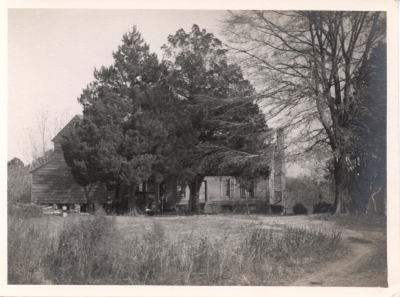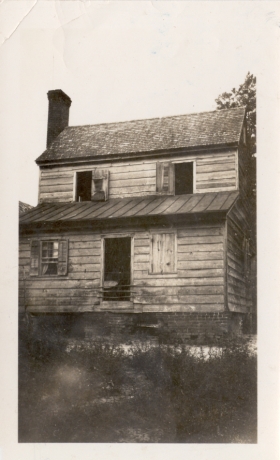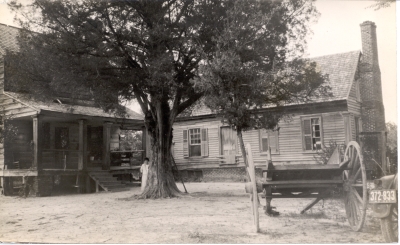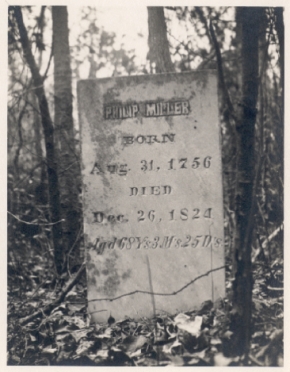Contributed typed by Martha M. Marble
Found in the Sybil Hyatt Collection located at the Lenoir County Public Library, Kinston, NC. There were pictures of the two homes and a picture of the stone of Philip Miller – born 31 August 1756 died 26 Dec 1824. This was typed as found.
Philip Miller was the son of Jacob and Catherine Miller, whose first home in this country is indicated by “Muellers” on the Plan of the City of New Bern by Baron Christopher von Graffenreid. This was near Trenton. Court was held there in 1713 and 1714, Jacob Miller being an esquire assistant. In 1715 the record indicates his house was burned in March or April and Court was then held at Capt. Wm. Handcock’s with Jacob Miller still serving in 1715 and 1716. His Will was written Sept. 1, 1732 and Dec. 19 1732, Catherine Miller was appointed administrator, giving bond for one thousand pounds.
Feb. 12, 1733, John Martin Franck, who married Philip Miller’s sister, Seville, sold his farm three hundred acres part of a tract lying on the south side of Trent River “commonly called and known by ye name of New Germany” surveyed for him June 5, 1711 to Philip Miller for 200 pounds and bought the place on Mill Creek at which he lived near Tuckahoe Creek where he built a saw mill, a grist mill besides the house now standing and barns. This farm is about five and a half miles from Trenton on the Trenton-Richlands road near Haywood – next word cut off – .Mr. Killingsworth now owns and lives on it. Philip Miller lived there until 1745 when he bought a grant on Joshua’s Creek which is now in Woodington Township, Lenoir County. The home probably burned because Philip Miller’s son, George Miller of Cumberland County, sold the place for 15 pounds.
Tradition in the Miller family says that Philip Miller met Charles Wesley at Charleston and brought him to his home where he visited for two weeks incognito on account of the great prejudice at that time against the very strict doctrines of the Wesleys.
The home Philip Miller built on Joshua’s Creek was a stronghold of Methodism. The third Philip Miller who was a soldier of the Revolution was a Methodist Preacher and he was killed by being thrown from his buggy as he was starting off to hold church. Nunn Miller often entertained the preacher and his wife for six months at the time. He contributed liberally to founding Greensboro Female College and contributed $1000 to founding Randolph-Macon College. He gave his children the change to graduate from college and some of them did.
Philip Miller I probably was born in the Palatinate as he signed his name in German script. He died in 1766 or prior thereto as his estate was mentioned in 1770. His son Philip Miller who also lived in the old house was born in 1734. He must have been dead in 1790 because he is not on the Census of 1790. Philip III was born August 31, 1756 and died Dec. 26, 1824. His son, Imla Nunn Miller was born March 10, 1801 died 1857 md May 6, 1828 Mary Parker, dau of John Parker and Angeline Loftin.
Philip Miller I built an eight roomed house, four rooms on the first floor, two on the second and two on the third and a porch and a cellar as large as the four rooms. The carpenter work on the house is excellent. The walls are made of planks twelve or more inches wide planed so smooth and fitted together so closely they look like they are plastered. They have been painted now but probably were not in the beginning. Probably during Nunn Miller’s life time a second house of five rooms and a cellar with a well in it was added and set at right angles to the first and joined to it by a porch which ran the length of the house. This porch was plastered overhead.
There was a building in the yard near where the houses joined containing two large rooms, one of which was used for weaving and one for a kitchen. There was a second story on the two room brick smoke house which also was used for weaving. The smoke house had one large room for meats and a small one with bins for flour, meal, sugar and so on.
There were twenty-three houses in the slave quarters and each house was allotted a piece of ground on which every slave could grow things to sell to Nunn Miller at the market prices and could keep the money for his personal spending money. They were allowed to visit back and forth with relatives on nearby plantations and to send packages to them. Some say he owed 150 some 200 and some 300 slaves and owned a large plantation in Georgia. Mary Parker had 12 slaves in her dower.
Nunn Miller was the largest slave holder in Lenoir and rented his slaves in western North Carolina and Georgia and Alabama. There is a letter in the Georgia state Library about his renting some of them to build a railroad. Every Sunday morning he made a trip around to hand out whatever medicine any of them needed.
There was a well built school house 30 by 60 feet at the bend of the road. The neighbors sent and some of the children boarded in the home. He employed some Northern teachers and two of Dr. Edwin A. Alderman’s aunts taught a Miller’s School House. Sunday school was held in the school house and a class record deposited with the N. C. Historical Commission (NC Archives today) lists 27 whites, 21 slaves and 14 free persons of color. The slaves are listed as colored members: Daniel Miller’s Dinah, George Perry’s Mourning, Joseph Kinsey’s Hannah, Wm. Brown’s Jonas and Maria, Wm Gooding’s Mary and Thursey, Isabella Small’s Levin., Council Goodin’s Henry and Dave and Redding, Evan William’s Alfred, Henderson Kinsey’s Clary, I. N. Miller’s Nancy, Charity, Anarchy, Lucindy, Anarchy (sic), Sip, Mary, Eveline, and Patsey.
There was a flower yard to the front of the house with crepe myrtles as high as a two story house, arbor vitae, sweet shrub, dalhias mimosa, seven sisters and may other kinds of roses, cape jessamine, burnish bush, star of Bethelem, jonquils, tiger lilies, wood bine honey suckles and many other old flowers. Nunn Miller’s son Frank (Francis Xavier) laid out the yard as a formal garden and took the greatest pleasure in making it beautiful.
They milked seventy cows and all the milk was taken care of in the cellar under the old houses, water run through it to keep the milk cool.
The records in Lenoir County were burned in 1878, but Mr. Wooten a lawyer of Kinston has told the family the list of Nunn Miller’s live stock was astonishing and that his will recited that he was leaving Mary Parker her share in fee simple because she had done as much as he had to earn it. It was customary at that time to lend to the wife her life time or her widowhood.
According to the book Coastal Plain and fancy, there was no known date of contruction for this house, but it was thought to have been built about 1820.
|




